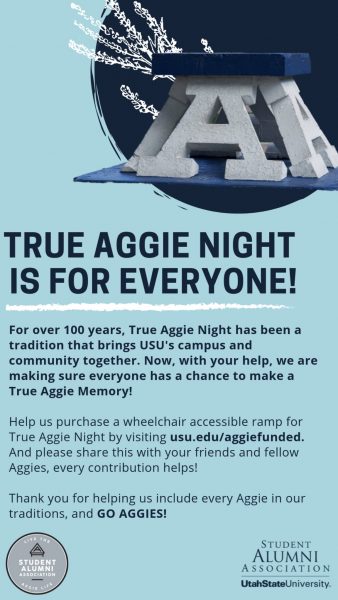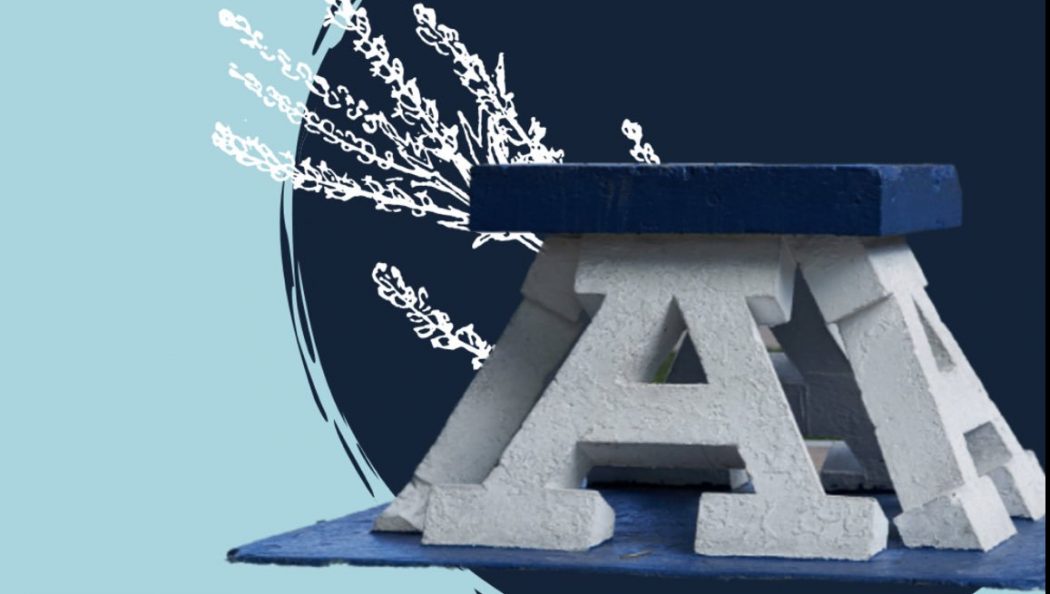Student Alumni Association fundraising for True Aggie Night accessibility ramps
Since the tradition began in 1916, becoming a True Aggie wasn’t designed for all students. But it wasn’t necessarily based on whether someone was comfortable standing on the Block A and kissing someone in public. No, the issue was getting on the Block A in the first place.
But now, after multiple students and alumni spoke out about it, the USU Student Alumni Association, or SAA, is now moving forward with plans to fundraise for and buy temporary wheelchair ramps, making events like True Aggie Night accessible for everyone.
“This is something that multiple people in my position have tried to accomplish and work on, but it’s never been approved until this year,” Tarren Jessop, SAA vice president, said. “We’re really excited that it’s gotten this far, and we’re really excited to show our students that inclusivity is more than your skin color or background, but it also includes your abilities.”
This year, with your help, we have the opportunity to make True Aggie Night wheelchair accessible! My team and I have been working hard on this all summer, and it would mean the most if you could donate or share this message! Everything helps! GO AGGIES!!!https://t.co/lUGdH0r4Eo
— Gingeraffe (@tarren_jessop) September 13, 2019
When True Aggie Night first began, the event was very unsupervised, with the Block A being swarmed by students and would have as many as eight people trying to stand on it at once. As it became more supervised and recognized by the university, they decided to have steel stairs constructed so students could easily access it.

However, the staircases didn’t cater to every student, and multiple students and alumni began to reach out to Jessop and her predecessors on the issue. Jessop said many of these people felt that there is an issue with ableism on campus, and she saw buying ramps as the perfect opportunity to address it.
“We’re really excited to be able to take these students’ voices and actually apply them to something that’s permanent, important and a fundamental part of Utah State culture,” Jessop said. “True Aggie Night is something we tell incoming students about and something alumni return for, and to be able to open the doors to this tradition for so many more people is really exciting for us.”
Getting ramps has been a mission for Jessop and other SAA officials for years, but this is the furthest a proposal has ever gone. Jessop said she thinks this proposal is the most successful because the ramps will be temporary and taken down immediately following events, therefore not changing the structure of the Block A but still making it more accessible and inclusive.
The ramps will be completely compliant with the federal Americans with Disabilities Act and will consist of two 17-foot sections that create a right angle leading up to the Block A on both sides. There will be platforms between those two 17-foot sections to provide space for students to position correctly atop the Block A, as well as safety handrails that extend across the whole structure. The ramps are completely collapsible and will be put up for True Aggie Nights, Parent Days and graduation.
“We’re hoping to have them for the next True Aggie Night,” Blake Barber, SAA director of fundraising, said. “We’ll see how that works out because we still need to purchase and build them, and it’s really dependent on how quickly we’re able to fundraise the money.”
SAA is hoping to raise $5,837 by Oct. 11, which is around half the cost of the ramps. The remaining half comes from internally raised money through student and alumni associations and money donated by the Class of 2019 as a senior gift.
Students, alumni and community members that want to help purchase the ramps can donate money at usu.edu/aggiefunded. Currently, around $1,500 has been raised, with donations continuously pouring in.
“Even if you don’t have the funds, it’s important for people to just spread the word,” Barber said. “I know not all students have a lot of money, but even sharing it on your story is big and asking your parents to share it as well because your parents are the ones who have friends who are alumni who may have a little bit more money to donate and give.”
Andrea Kate, an English education major, donated as soon as she heard about it. Having a brother who is wheelchair bound, she said the issue was very personal to her and she’s happy action is being taken; however, she’s confused why it took so long to happen and why so much fundraising is needed.
“We’ve had wheelchair-bound students on this campus for decades, and the fact that they haven’t been able to participate in a very proud tradition that is iconic to the university is really frustrating,” she said. “The Americans with Disabilities Act has been around since the ‘90s, and I’m kind of annoyed we have to fundraise for something like this. You’d think the university could spare some money towards it or get a grant to pay for it.”
While Jessop says she understands where the criticism is coming from, she says she hopes the fundraising aspect will promote university involvement and make students and alumni proud that they helped increase campus inclusivity.
“I actually didn’t even know they were doing this fundraiser until now, so I wish there was more promotion for it, because it’s a really great cause,” Camila Summers, a biochemistry major, said. “I wish there wasn’t a minimum donation amount of $5 because I think we can all give a little bit, but not all students can give the same amount. I think they’d have a higher chance of raising more money that way.”
On the other hand, Barber said that the small donation is definitely feasible if students just make a conscious effort and choose to put their funds towards a good cause.
“If you skip the breakfast burrito tomorrow and just donate that $5 to the ramps, it’ll make a big difference in the long run for a lot of Aggies here at USU and a lot of future Aggies,” he said. “I think that’s something a lot of students can take pride in.”
—nichole.bresee@aggiemail.usu.edu
@breseenichole

